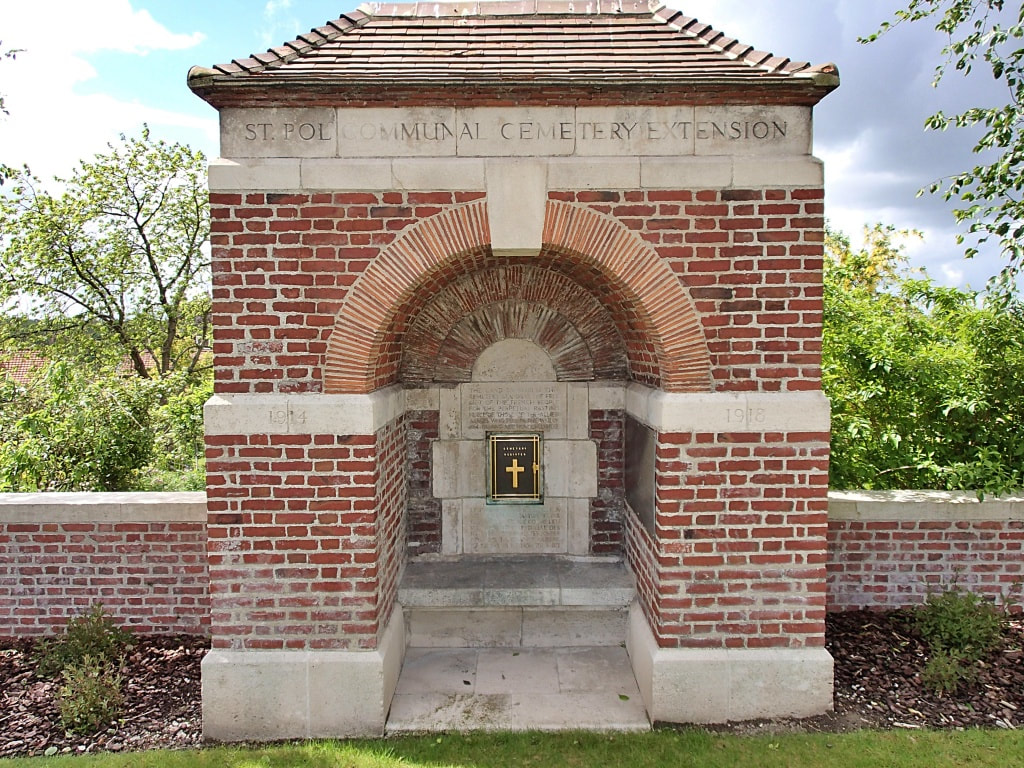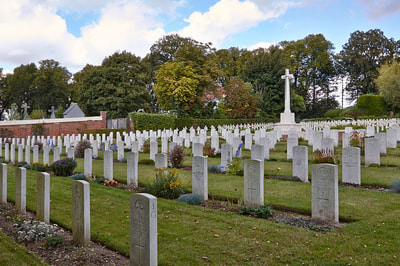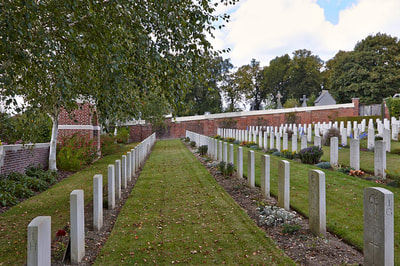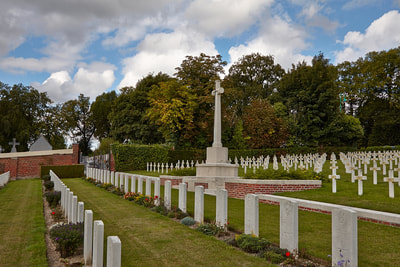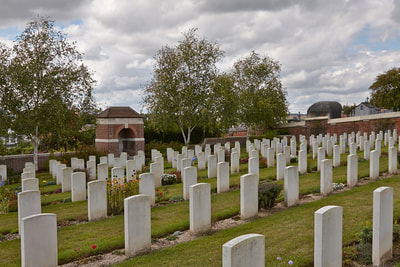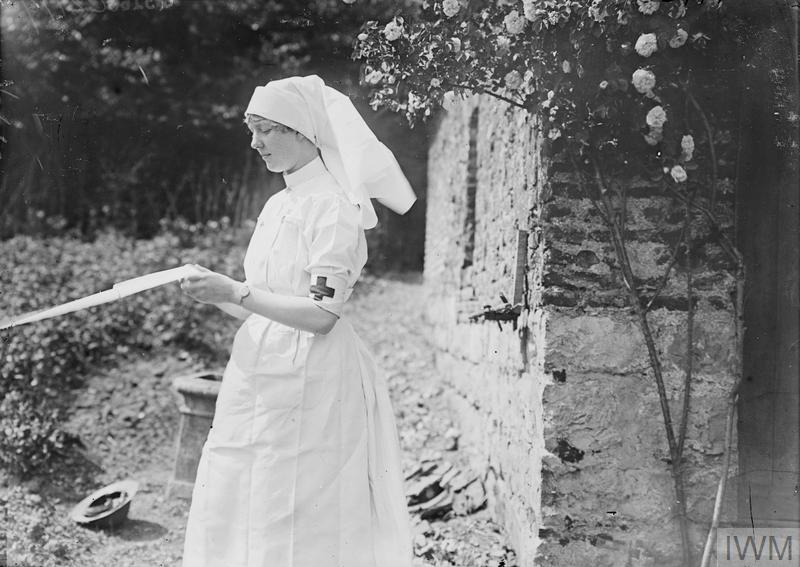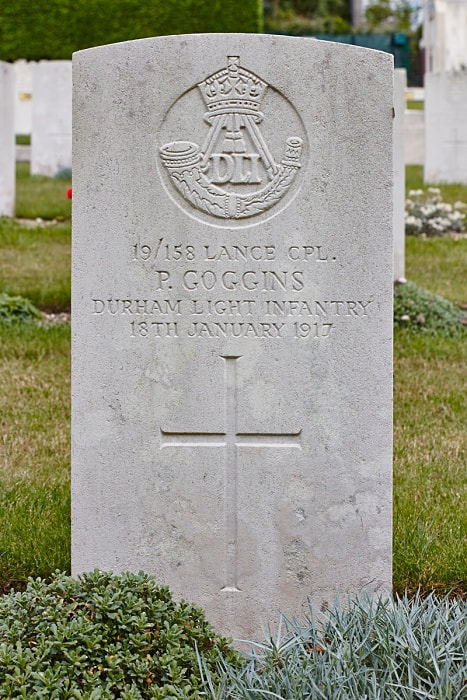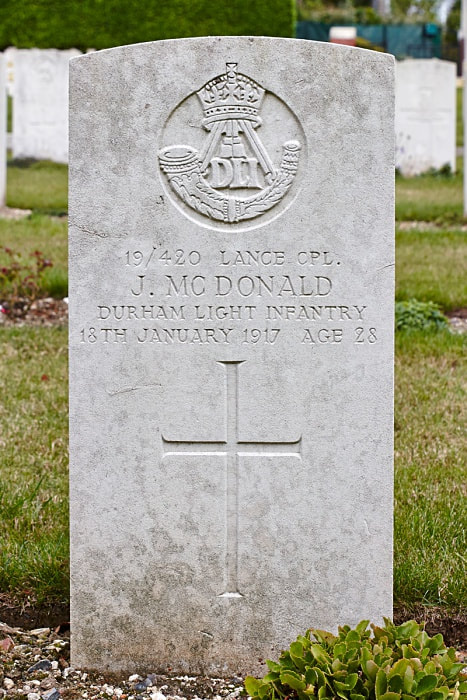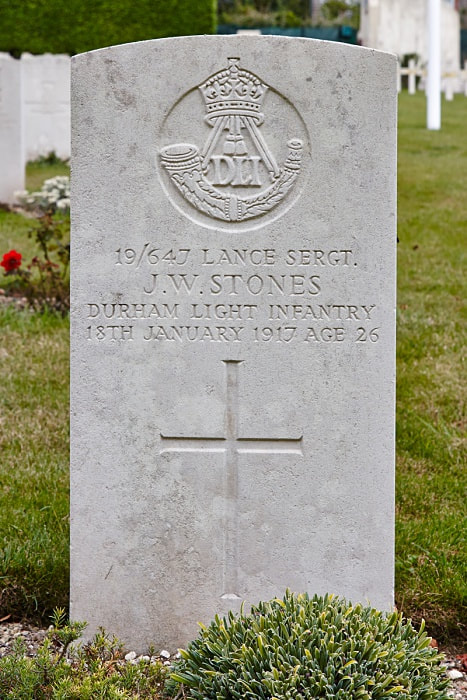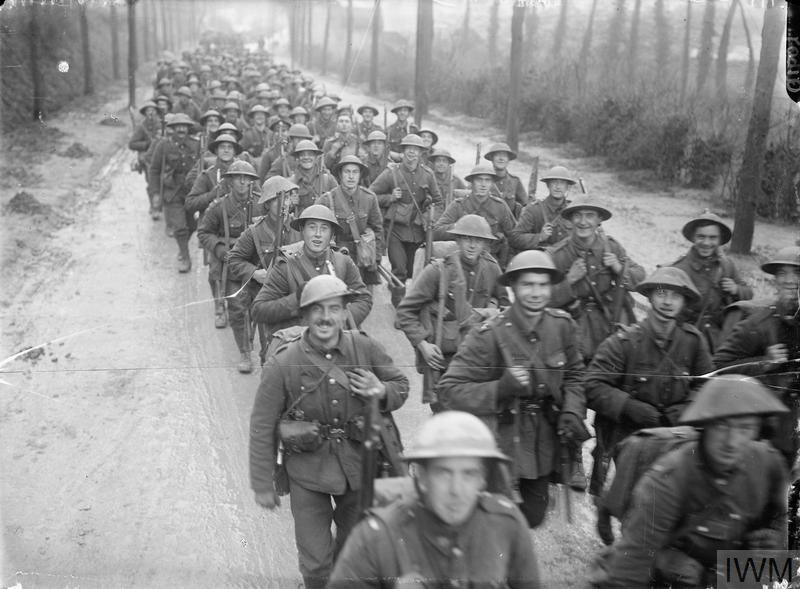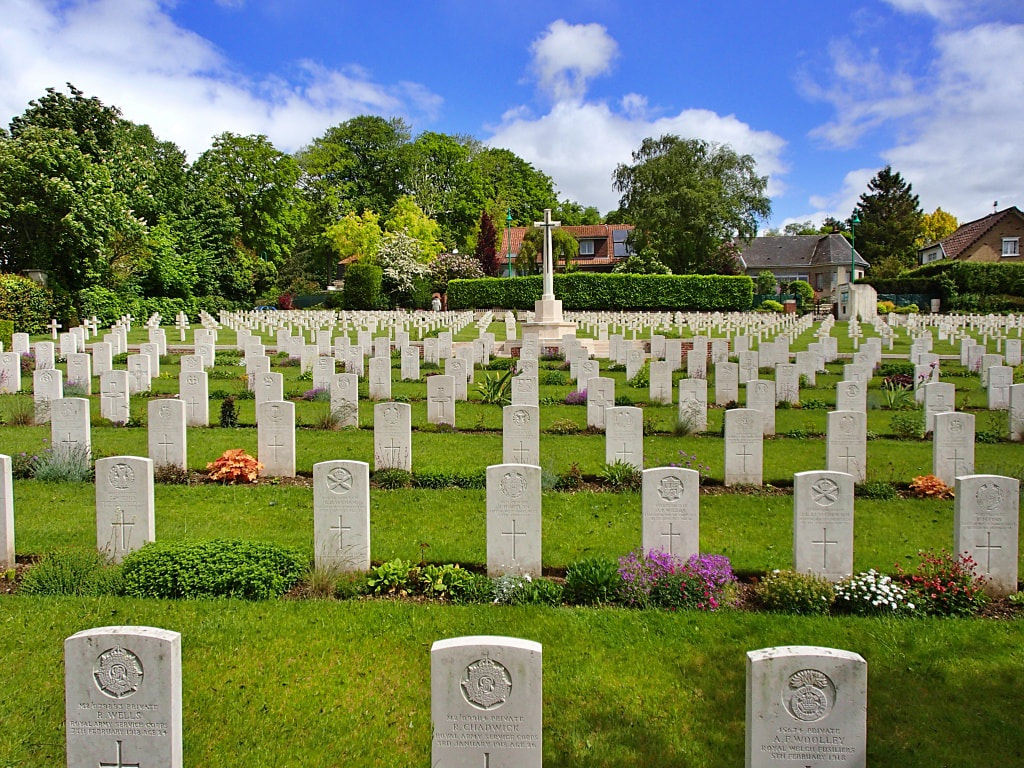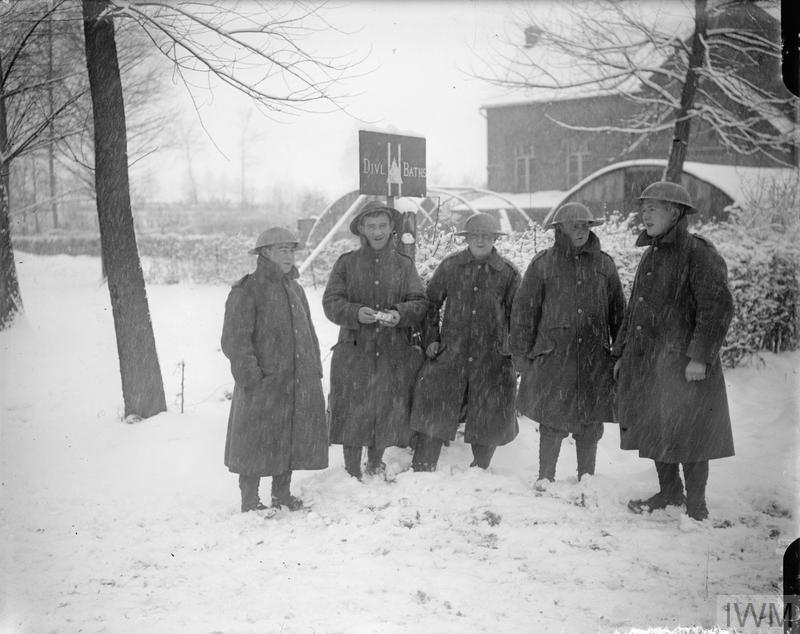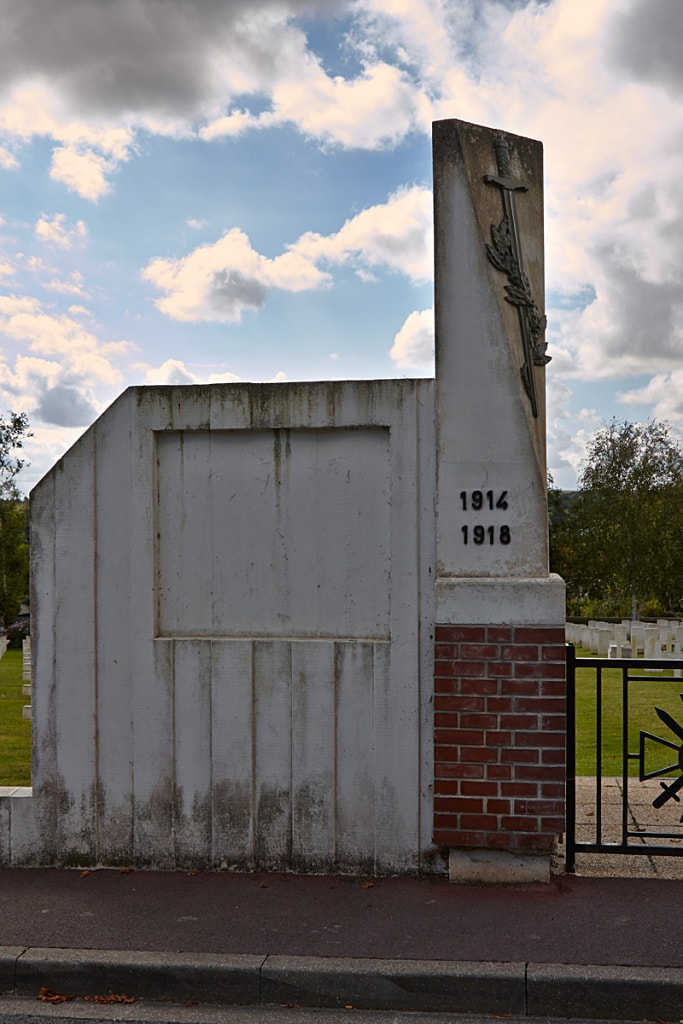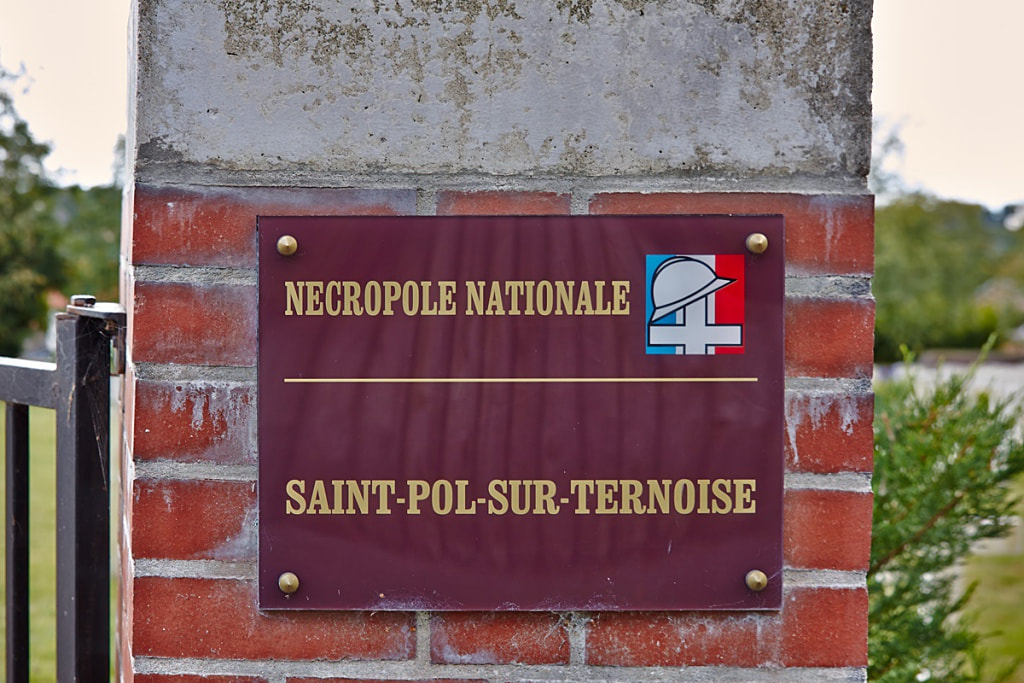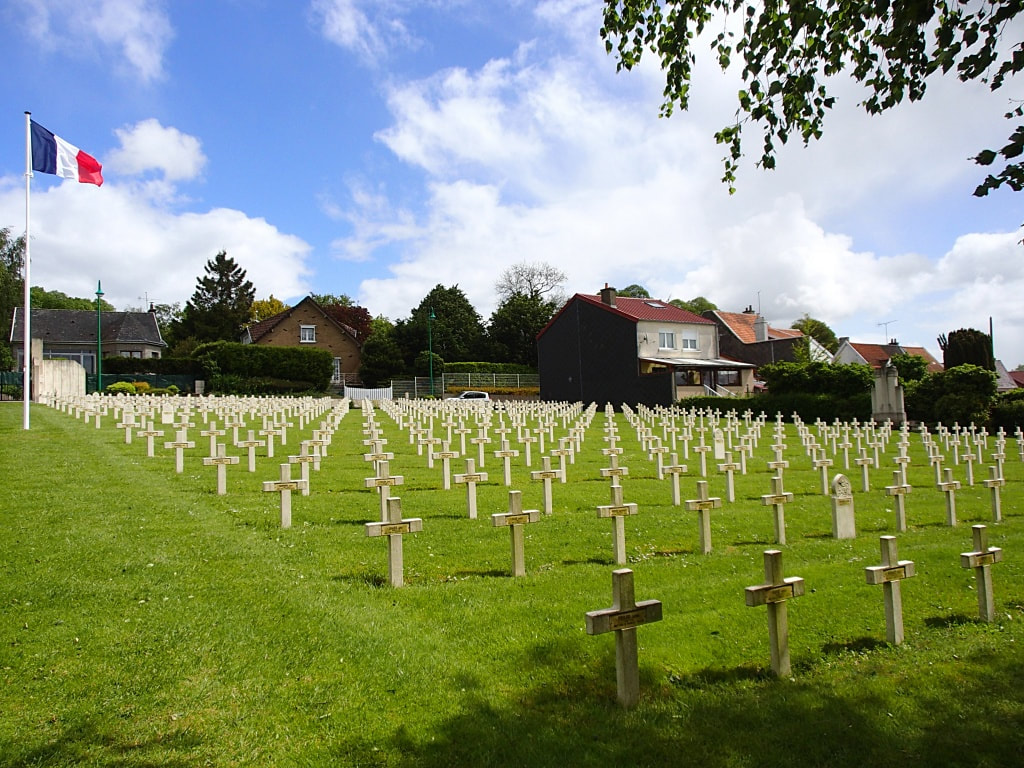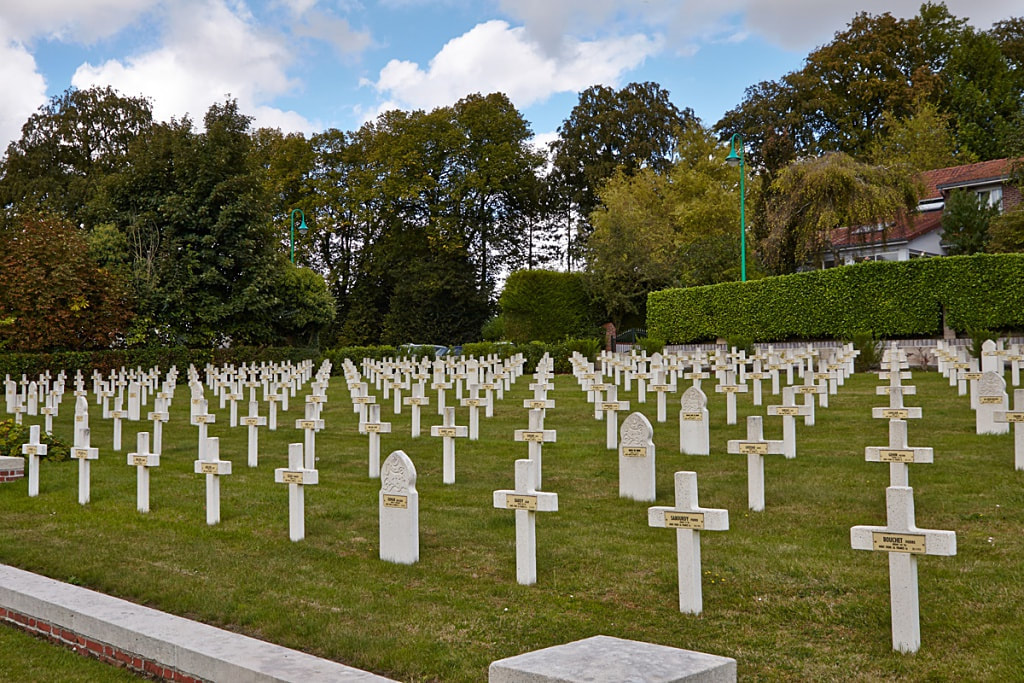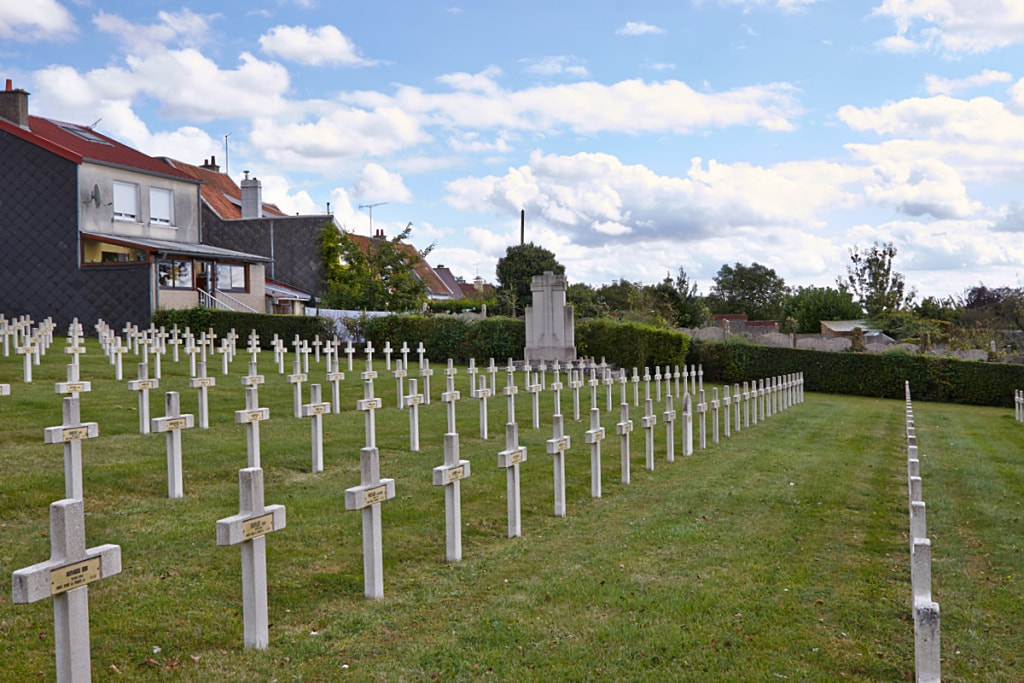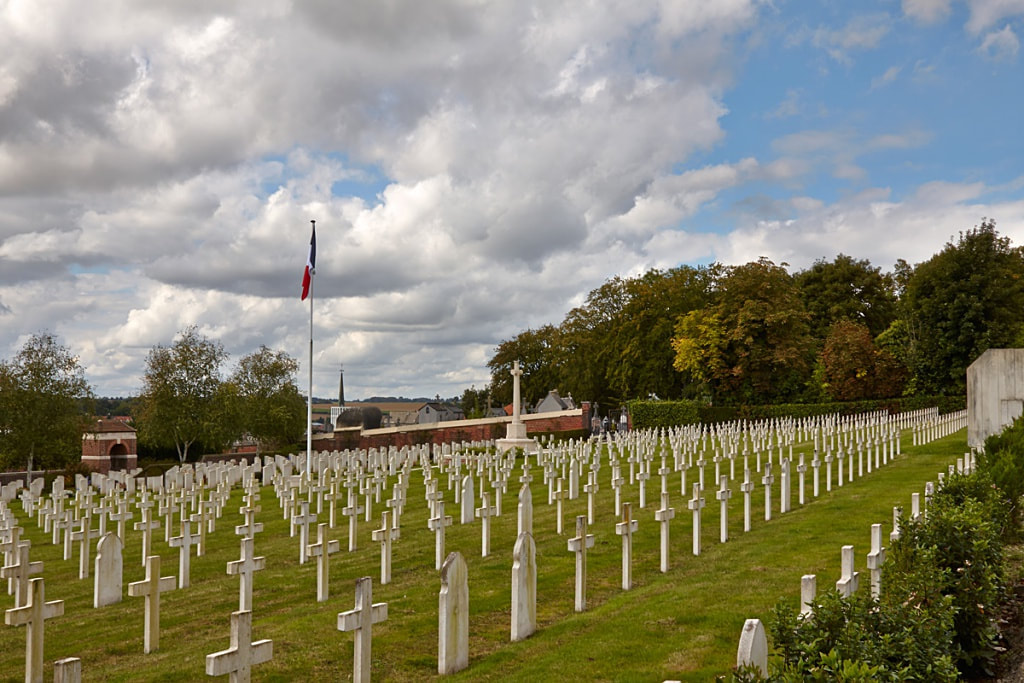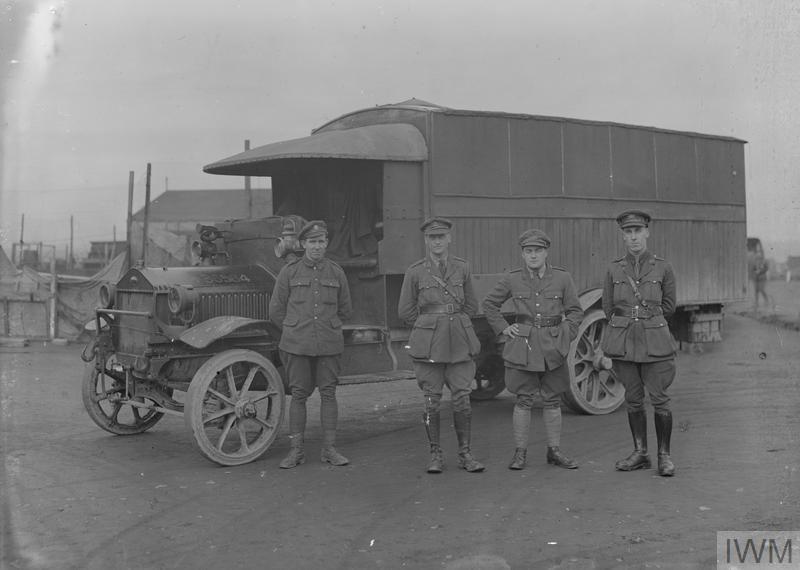ST. POL COMMUNAL CEMETERY EXTENSION
Pas De Calais
France
GPS Coordinates: Latitude: 50.38141, Longitude: 2.34258
Location Information
The town of St Pol is about 29 kilometres south-west of Bethune and 34 kilometres west-north-west of Arras. The Communal Cemetery Extension is situated on high ground next to the old Communal Cemetery and is reached by a steep road, Rue de Cimetiere, on the north side of the old N39 road to Arras.
Historical Information
St. Pol-sur-Ternoise was an administrative centre during the whole of the war, taken over by British troops from the French in March 1916; and No.12 Stationary Hospital was posted on the race-course near the town from the 1st June 1916, to 1st June 1919.
The Extension was made alongside the "Cimetiere Thuillier" (which is more than 500 years old) by the French Tenth Army, and in March 1916-April 1918, the British Plot was added in the South-West quarter.
The cemetery was designed by Arthur James Scott Hutton
There are now 226, 1914-18 war casualties commemorated in this site.
The British Plot covers an area of 1,111 square metres.
Total Burials: 226.
Identified Casualties: United Kingdom 209, Canada 7, New Zealand 4, Australia 3, India 1, South Africa 1. Total 225.
Cemetery images in this gallery © Geerhard Joos
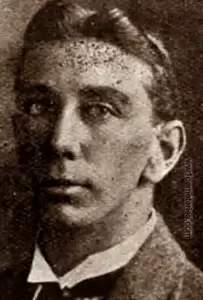
5/884 Corporal
Bert Barnett
New Zealand Army Service Corps
8th March 1917, aged 24.
Row E. 13.
Son of Walter and Elizabeth Barnett of Auckland, New Zealand.
Bert Barnett
New Zealand Army Service Corps
8th March 1917, aged 24.
Row E. 13.
Son of Walter and Elizabeth Barnett of Auckland, New Zealand.
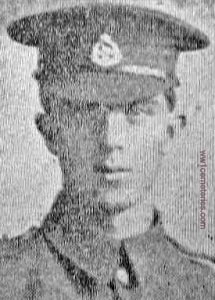
18826 Private
Thomas Blamire
1st Bn. East Lancashire Regiment
9th July 1916.
Row B. 1.
Son of Mr. W. Blamire, of 4, Gorple St., Harle Syke, Burnley.
Thomas Blamire
1st Bn. East Lancashire Regiment
9th July 1916.
Row B. 1.
Son of Mr. W. Blamire, of 4, Gorple St., Harle Syke, Burnley.
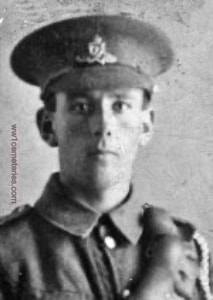
W/5444 Gunner
Robert Charles Garrett
"B" Bty. 122nd Bde. Royal Field Artillery
24th June 1916, aged 19.
A. 16.
Son of Edward Garrett, of 7, Orry St., Douglas, Isle-of-Man, and the late C. Garrett.
His headstone bears the inscription; "Gone But Not Forgotten."
Robert Charles Garrett
"B" Bty. 122nd Bde. Royal Field Artillery
24th June 1916, aged 19.
A. 16.
Son of Edward Garrett, of 7, Orry St., Douglas, Isle-of-Man, and the late C. Garrett.
His headstone bears the inscription; "Gone But Not Forgotten."

Lieutenant
Alexander Brown Grindlay
11th Bn. Royal Scots
24th March 1917, aged 24.
Row c. 29.
Son of Charles and Mary Grindlay, of "Elim", Errol. Perthshire.
Alexander Brown Grindlay
11th Bn. Royal Scots
24th March 1917, aged 24.
Row c. 29.
Son of Charles and Mary Grindlay, of "Elim", Errol. Perthshire.
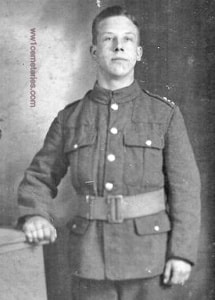
70920 Sapper
Albert Christian Havelock
R. R. Cable Section, Royal Engineers
27th March 1916.
Row A. 3.
Son of Charles Havelock, of 86, Clonmore St. Southfields, Wandsworth, London.
Albert Christian Havelock
R. R. Cable Section, Royal Engineers
27th March 1916.
Row A. 3.
Son of Charles Havelock, of 86, Clonmore St. Southfields, Wandsworth, London.
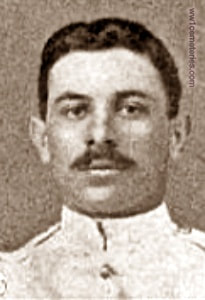
9389 Serjeant
William Mack, D. C. M.
2nd Bn. Seaforth Highlanders
30th May 1917.
Row F. 29.
Husband of Catherine Mack.
William Mack, D. C. M.
2nd Bn. Seaforth Highlanders
30th May 1917.
Row F. 29.
Husband of Catherine Mack.
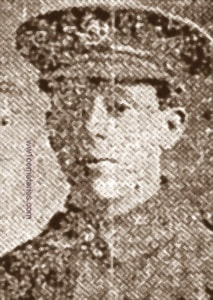
13/482 Private
George Alfred Morley
13th Bn. York and Lancaster Regiment
1st August 1916.
Row B. 21.
Son of Mr. C. H. Morley, of 181, Pontefract Rd., Cudworth, Barnsley.
George Alfred Morley
13th Bn. York and Lancaster Regiment
1st August 1916.
Row B. 21.
Son of Mr. C. H. Morley, of 181, Pontefract Rd., Cudworth, Barnsley.
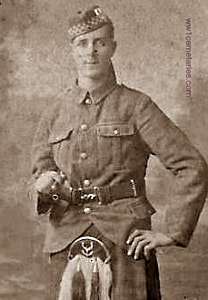
4595 Private
Jacob Park
5th Bn. Seaforth Highlanders
13th June 1916, aged 22.
Row A. 11.
Son of Mr. and Mrs. T. Park, of "Dochrie", Belmont Church Rd., Belfast.
His headstone bears the inscription; "Not Dead But Sleeping."
Jacob Park
5th Bn. Seaforth Highlanders
13th June 1916, aged 22.
Row A. 11.
Son of Mr. and Mrs. T. Park, of "Dochrie", Belmont Church Rd., Belfast.
His headstone bears the inscription; "Not Dead But Sleeping."
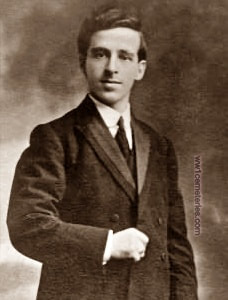
S/26767 Private
William John Peden
1st Bn. Cameron Highlanders
8th March 1917, aged 29.
Row E. 12.
Son of William and Maria Peden, of 73, Springburn Rd., Springburn, Glasgow.
His headstone bears the inscription; "Missionary Of St. James' U.F. Church And Student Of Glasgow University."
William John Peden
1st Bn. Cameron Highlanders
8th March 1917, aged 29.
Row E. 12.
Son of William and Maria Peden, of 73, Springburn Rd., Springburn, Glasgow.
His headstone bears the inscription; "Missionary Of St. James' U.F. Church And Student Of Glasgow University."
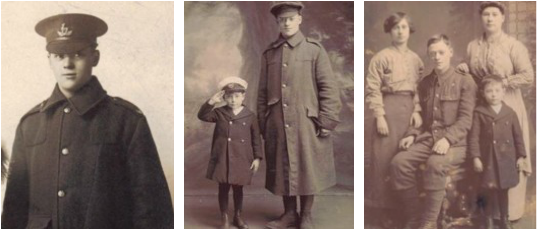
2550 Private
Ambrose Perkins
8th Bn. Royal Warwickshire Regiment
3rd July 1916, aged 22.
Row A. 22.
Son of Mr. F. Perkins, of 299, Farm St., Hockley, Birmingham
Picture 1: Ambrose Perkins
Picture 2: Ambrose Perkins with his brother Horace
Picture 3: Ambrose Perkins with his mother, sister and brother Horace
Pictures courtesy Dianne Moores, great-niece

4/1543 Corporal
Reuben Robert Rooney
New Zealand Engineers
21st August 1916, aged 34.
Row B. 19.
Son of Catherine Rooney, of 183, Melville St., Hobart West, Tasmania, and the late William Rooney.
Reuben Robert Rooney
New Zealand Engineers
21st August 1916, aged 34.
Row B. 19.
Son of Catherine Rooney, of 183, Melville St., Hobart West, Tasmania, and the late William Rooney.
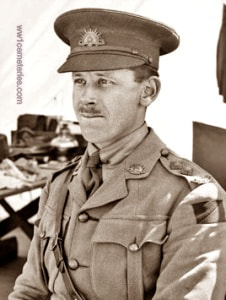
Lieutenant
James Lionel Montague Sandy
69th (R. F. C.) Sqdn. Australian Flying Corps
17th December 1917, aged 32.
Row H. 8.
Son of James Montague Sandy and Evaline Martha Sandy, of "Blenheim", Burwood, New South Wales. Native of Ashfield, Sydney, New South Wales.
His headstone bears the inscription; "Beloved Eldest Son Of J.M. & E.M. Sandy, Sydney. Deeply Mourned."
James Lionel Montague Sandy
69th (R. F. C.) Sqdn. Australian Flying Corps
17th December 1917, aged 32.
Row H. 8.
Son of James Montague Sandy and Evaline Martha Sandy, of "Blenheim", Burwood, New South Wales. Native of Ashfield, Sydney, New South Wales.
His headstone bears the inscription; "Beloved Eldest Son Of J.M. & E.M. Sandy, Sydney. Deeply Mourned."
Shot at Dawn
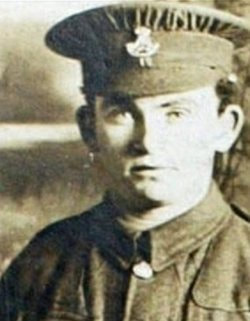
19/158 Lance Corporal
Peter Goggins
19th Bn. Durham Light Infantry
Executed for quitting his post, 18th January 1917.
Row D. 2.
Husband of Mrs. M. Goggins, of 58, South St., South Moor, Stanley, Co. Durham.
Peter Goggins
19th Bn. Durham Light Infantry
Executed for quitting his post, 18th January 1917.
Row D. 2.
Husband of Mrs. M. Goggins, of 58, South St., South Moor, Stanley, Co. Durham.

19/647 Lance Serjeant
Joseph William Stones
19th Bn. Durham Light Infantry
Executed for casting away his arms
18th January 1917.
Row D. 1.
Husband of Elizabeth Edith Jones (formerly Stones), of 85, Wheatbottom, Crook, Co. Durham.
Joseph William Stones
19th Bn. Durham Light Infantry
Executed for casting away his arms
18th January 1917.
Row D. 1.
Husband of Elizabeth Edith Jones (formerly Stones), of 85, Wheatbottom, Crook, Co. Durham.
19/420 Lance Corporal, John McDonald, 19th Bn. Durham Light Infantry, executed for quitting his post, 18th January 1917, aged 28. Row D. 3. Son of Malcolm and Joanina McDonald, of Sunderland; husband of Hannah McDonald, of 29, Hartley's Buildings, Millfield, Sunderland.
On 26 Nov 1916, in a sparsely held part of the line at Roclincourt, near Arras that had been frequently subject to the detonation of mines, an officer led a night-time patrol to the King’s Crater, only 50 yards from the enemy front-line. There a German raiding party shot & wounded the officer; & Stones left his rifle & made off towards the rear to give the alarm — to be arrested by the police at a battle stop.
Nearby in another section of the same line, a party of 6 men made off, headed by Goggins & McDonald (without their rifles), reaching a sentry-post some 200 yards behind the front line.
At the trial on Christmas Eve of the 3 NCOs, along with the 4 Privates, it was confirmed on behalf of Stones that at the time of his arrest he had been in a nervous state, with difficulty in walking, but the battalion doctor had merely reported the absence of organic disorder. Despite Stones’ good fighting record, he was sentenced to death. In respect of the 6 men led by Goggins & McDonald, all charged with quitting their posts, there was evidence of an unauthorised order to retire. However all 6 received the same sentence as Stones.
Against a background of prejudice against Bantam battalions then prevalent amongst senior officers, the Divisional commander described Goggins & McDonald as mentally & physically degenerate. On review, Haig commuted the sentences on the 4 Privates to imprisonment for 15 years, suspended.
(Putkowski, pp. 156-9; Corns, pp. 157-175, giving a full & detailed account (with a map) of the incidents giving rise to the charges; of the fighting in the area; & of the lengthy trial proceedings).
On 26 Nov 1916, in a sparsely held part of the line at Roclincourt, near Arras that had been frequently subject to the detonation of mines, an officer led a night-time patrol to the King’s Crater, only 50 yards from the enemy front-line. There a German raiding party shot & wounded the officer; & Stones left his rifle & made off towards the rear to give the alarm — to be arrested by the police at a battle stop.
Nearby in another section of the same line, a party of 6 men made off, headed by Goggins & McDonald (without their rifles), reaching a sentry-post some 200 yards behind the front line.
At the trial on Christmas Eve of the 3 NCOs, along with the 4 Privates, it was confirmed on behalf of Stones that at the time of his arrest he had been in a nervous state, with difficulty in walking, but the battalion doctor had merely reported the absence of organic disorder. Despite Stones’ good fighting record, he was sentenced to death. In respect of the 6 men led by Goggins & McDonald, all charged with quitting their posts, there was evidence of an unauthorised order to retire. However all 6 received the same sentence as Stones.
Against a background of prejudice against Bantam battalions then prevalent amongst senior officers, the Divisional commander described Goggins & McDonald as mentally & physically degenerate. On review, Haig commuted the sentences on the 4 Privates to imprisonment for 15 years, suspended.
(Putkowski, pp. 156-9; Corns, pp. 157-175, giving a full & detailed account (with a map) of the incidents giving rise to the charges; of the fighting in the area; & of the lengthy trial proceedings).

